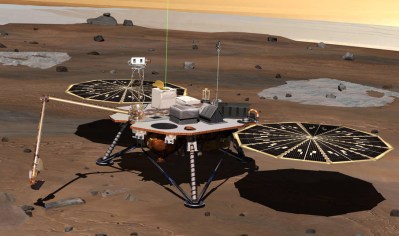 Unless you’ve got your ear on the launch pad so to speak, you might not be aware that humanity just launched a new envoy towards the Red Planet. Estimated to touch down in Elysium Planitia on November 26th, the InSight lander is relatively low-key as far as interplanetary missions go. Part of the NASA’s “Discovery Program”, it operates on a considerably lower budget than Flagship missions such as the Curiosity rover; meaning niceties like a big advertising and social media campaign to get the public excited doesn’t get a line item.
Unless you’ve got your ear on the launch pad so to speak, you might not be aware that humanity just launched a new envoy towards the Red Planet. Estimated to touch down in Elysium Planitia on November 26th, the InSight lander is relatively low-key as far as interplanetary missions go. Part of the NASA’s “Discovery Program”, it operates on a considerably lower budget than Flagship missions such as the Curiosity rover; meaning niceties like a big advertising and social media campaign to get the public excited doesn’t get a line item.
Which is a shame, because not only are there much worse things to do with tax money than increase public awareness of scientific endeavours, but because InSight frankly deserves a bit more respect than that. Featuring a number of firsts, the engineers and scientists behind InSight might have been short on dollars, but ambition was in ample supply.
So in honor of the successful launch, let’s take a look at the InSight mission, the unique technology onboard, and the answers scientists hope it will be able to find out there in the black.
A Mission That Almost Wasn’t
Originally, InSight was supposed to launch in March 2016. But just three months before the scheduled liftoff, one of the key instruments on the lander was found to be defective during final checks. NASA determined a fix couldn’t be developed and adequately tested in time, leaving them no choice but to abandon the 2016 launch window.
Due to the orbits of Earth and Mars, optimal launch opportunities only come around every 26 months. Which meant that not only would NASA have to pay to have InSight carefully stored for two years, but also fund the redesign of the failed instrument. All told, the delay would end up costing the agency $150 million dollars. An especially painful number when you consider the entire budget for the design, construction, and operation of InSight was only $675 million up to that point.
The task of solving the problem on such short notice was given to NASA’s Jet Propulsion Laboratory. Had they failed to design and test a fix for the problem during the 26 month delay, it’s entirely possible the mission would have been scrapped altogether. Thanks to the against the clock engineering efforts of JPL, InSight is currently on the way to Mars instead of languishing in some NASA storage building.
Old Ride, New Gear

If InSight looks familiar, don’t worry, it’s not your memory playing tricks on you: the lander is based on the same platform as the Phoenix mission which touched down on Mars in 2008.
Building on proven designs like this not only increases the likelihood of mission success, but as an added bonus, is cheaper than designing a new vehicle from scratch. NASA is currently developing a new Mars rover based on Curiosity which is currently slated to depart for the Red Planet during the 2020 launch window, and of course the twin rovers Spirit and Opportunity were massive successes.
The primary difference between the two craft is the array of science experiments onboard. InSight’s goal is to help us better understand the inside of Mars, and naturally the equipment it’s bringing reflects that. The star of the show is the Seismic Experiment for Interior Structure (SEIS), a tool to measure not only internal phenomena such as quakes, but how the Martian crust and mantle are effected by meteorite impacts. Incidentally, this is the same piece of equipment which failed its pre-flight checks and caused the two year mission delay. But given how integral it is to the scientific goals of the mission, it’s understandable why NASA didn’t want InSight to leave home without it.
While SEIS is likely to provide the most data on this mission, the Heat Flow and Physical Properties Package is arguably the flashiest. Nicknamed “The Mole”, this device is designed to burrow itself down 5 meters (~16.5 feet) into the Martian soil; far deeper than any instrument has ever gone before. Behind it will be a tether containing a sensitive thermometer every 10 cm (~4 inches), which will be used to determine the temperature gradient of the Martian crust. The hope is that this will shed some light on exactly how much heat is coming from the planet’s core.
Deep Space CubeSats
The InSight lander wasn’t the only thing carried into space by the Alas V rocket at liftoff. Shortly after the cruise stage (the spacecraft that actually carries InSight to Mars) separated from the booster, two identical CubeSats were deployed on the same trajectory. Referred to as Mars Cube One (MarCO) A and B, these are the first CubeSats to ever venture into deep space. They will fly in formation with InSight on the way to Mars, and if they manage to make it all the way there, will assist Ground Control by acting as signal relays during the lander’s entry into the Martian atmosphere.
Communicating with an object the size of a briefcase from 225 million kilometers away is no small feat, as [Nacer Chahat] explained during his interview with Hackaday last year, so NASA is careful not to promise too much with the MarCO spacecraft. But it’s safe to say a lot of eyes will be on this experiment. CubeSats are already a very popular choice for performing science in Earth orbit. If NASA can show that these diminutive craft can survive the harsh conditions encountered during interplanetary flight, it could open up a whole new market.
Now We Wait
We’ve gotten a lot better at sending craft to Mars over the decades, but it’s still not without risk. It’s a treacherous six month journey through the void that separates our worlds, and that’s not even the hard part. Once InSight arrives at Mars, it’s going to have to perform a complex autonomous landing while we are forced to watch as spectators.
The fact that we’re able to do it at all is a testament to the incredible engineers and scientists that pour their heart and soul into these craft. Everyone here at Hackaday is wishing the InSight team the best of luck, and we’re looking forward to following along as the mission progresses.















Interesting just how tailored sensors are to their platform. Just think if that defective sensor could be easily swapped out, even with testing.
The sensors are not tailored to their platform, they typically are designed for it.
Those Cubesats are already a ways away!
https://www.nasa.gov/feature/jpl/a-pale-blue-dot-as-seen-by-a-cubesat
The Hackaday artist drew rocket jets coming out of the feet of the lander. That’s definitely not how it works.
No, those are spigots pouring hot lava onto the Martian surface.
they’re not Musk’s Boring Company flamethrowers? :)
I hope all goes well, the next optimal launch window is in 2020, I look at this in total amazement:
https://twitter.com/CJHandmer/status/980536332786196480
Why? Have you SEEN Mars? Just build underground habitats in the Gobi Desert.
“The task of solving the problem on such short notice was given to NASA’s Jet Propulsion Laboratory. Had they failed to design and test a fix for the problem during the 26 month delay, it’s entirely possible the mission would have been scrapped altogether.”
What are you talking about? The French Space Agency designed an built the leaky seismometer that caused the mission delay.
CNES (French Space Agency ) Vows To Get to the Bottom of Leaks that Forced Mars InSight Delay
http://spacenews.com/cnes-vows-to-get-to-the-bottom-of-leaks-that-forced-mars-insight-delay/
CNES is prime contractor for the Seismic Experiment for Interior Structure (SEIS) instrument — three seismometers designed to analyze the Mars interior by detecting ground movement from small seismic events in the Mars interior.
One French official said the SEIS seismometers were so demanding that their development may have obscured the challenge of the titanium vacuum sphere, intended to operate in a temperature range beyond which that material is normally tested.
A first leak, appearing in November, was repaired in time for the March launch. Then another appeared, and then another. Up until Dec. 22 NASA and CNES had hoped to be able to deliver SEIS (already three months behind schedule) by Jan. 5 — just within the latest deadline to make the March launch.
A final leak, apparently from a different location, resulted in the decision to abandon the 2016 launch opportunity. Le Gall said the leak source was still not entirely clear. CNES officials have said it would take several months to get to the bottom of the problem.
What part don’t you understand? It was built by the French, didn’t work properly, and then NASA had JPL redesign and fix it.
I cant believe that it cost $150 million to store it! Admittedly, that price also included the new gear, but still! Somebody must be making a killing renting out old aircraft hangers (or maybe some souped-up shipping containers).
I’d imagine it has to be stored in a clean room, and probably kept powered so it can be checked occasionally. So not exactly tossed in a closet. But yeah, that’s a hell of a bill.
I wonder what the breakdown was between fix/store. It’s NASA, so it should be public info.
In addition, maybe the clean room need to be very cold and at a vacuum (like it would experience in space)
Late to the party here but a large part of this “storage” fee is actually salary retention for all the staff that the mission requires. They could have chosen to pair it down but they may have also lost critical members for the mission to be successful.
I can’t have been the only one to notice the firefly reference in this article, right?
http://3.bp.blogspot.com/-pDJkQTML2l4/UGwweGmvuTI/AAAAAAAAGTI/cnh3lNtkW3k/s1600/Lord,+Grant+me+the+Serenity.jpg
Project Insight, i’m sure i have heard that before does it have a targeting computer and have a German scientist on the team all featuring in a previously released Marvel film.
I am just waiting to see when the first flight will go to Mars and what information they will send us from there!